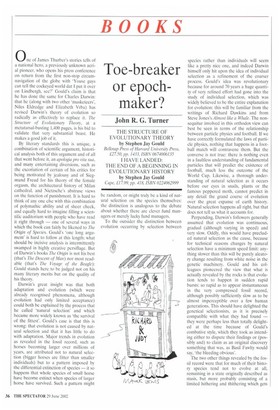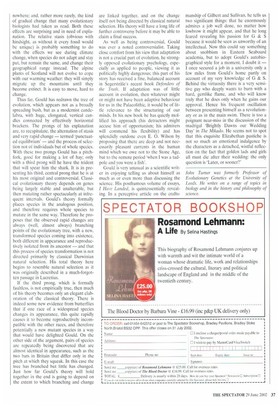Toe-breaker or epoch maker?
John R. G. Turner
THE STRUCTURE OF EVOLUTIONARY THEORY by Stephen Jay Gould
Belknap Press of Harvard University Press, £27.50, pp. 1433, ISBN 0674006135
I HAVE LANDED: THE END OF A BEGINNING IN EVOLUTIONARY HISTORY by Stephen Jay Gould
Cape, £17.99, pp. 418, ISBN 0224062999
0 Ile of James Thurber's stories tells of a national hero, a previously unknown aerial pioneer, who opens his press conference on return from the first non-stop circumnavigation of the globe with `Youse guys can tell the cockeyed world dat I put it over on Lindbergh, see?' Gould's claim is that he has done the same for Charles Darwin: that he (along with two other 'musketeers', Niles Eldredge and Elizabeth Vrba) has revised Darwin's theory of evolution so radically as effectively to replace it. The Structure of Evolutional); Theory, at a metatarsal-busting 1,400 pages, is his bid to validate that very substantial boast. He makes a good job of it.
By literary standards this is unique, a combination of scientific argument, historical analysis both of this argument and of all that went before it, an apologia pro vita sua, and many entertaining diversions, such as the excoriation of certain of his critics for being motivated by jealousy and of Siegmund Freud for his theory of the female orgasm, the architectural history of Milan cathedral, and Nietzsche's abstruse views on the function of punishment. It is hard to think of any one else with this combination of polymathic ability and of sheer cheek, and equally hard to imagine filling a scientific auditorium with people who have read it right through — one of several ways in which the book can fairly be likened to The Origin of Species. Gould's 'one long argument' is hard to follow at this length; what should be incisive analysis is intermittently swamped in highly creative persiflage. But of Darwin's books The Origin is not his best (that's The Descent of Man) nor most readable (that's The Voyage of the Beagle): Gould stands here to be judged not on his many literary merits but on the quality of his theory.
Darwin's great insight was that both adaptation and evolution (which were already recognised phenomena, although evolution had only limited acceptance) could both be explained by the process that he called 'natural selection' and which became more widely known as 'the survival of the fittest'. Gould's case is that this is wrong: that evolution is not caused by natural selection and that it has little to do with adaptation. Major trends in evolution as revealed in the fossil record, such as horses becoming larger over millions of years, are attributed not to natural selection (bigger horses are fitter than smaller individuals) but to a pattern imposed by the differential extinction of species — it so happens that whole species of small horse have become extinct when species of larger horse have survived. Such a pattern might be random, or might truly be a kind of natural selection on the species themselves: the distinction is analogous to the debate about whether there are clever fund managers or merely lucky fund managers.
To the outsider the distinction between evolution occurring by selection between species rather than individuals will seem like a pretty nice one, and indeed Darwin himself only hit upon the idea of individual selection as a refinement of the coarser process. Gould's idea was revolutionary because for around 70 years a huge quantity of very refined effort had gone into the study of individual selection, which was widely believed to be the entire explanation for evolution: this will be familiar from the writings of Richard Dawkins and from Steve Jones's Almost like a Whale. The nonsequitur involved in this orthodox view can best be seen in terms of the relationship between particle physics and football. If we have correctly formulated the laws of particle physics, nothing that happens in a football match will contravene them. But the converse is not true: there is nothing even in a faultless understanding of fundamental particles that will predict the existence of football, much less the outcome of the World Cup. Likewise, a thorough understanding of natural selection as it occurs before our eyes in snails, plants or the famous peppered moth, cannot predict in any detail the grand course of evolution over the great expanse of earth history. Natural selection happens all right, but that does not tell us what it accounts for.
Perpending, Darwin's followers generally assumed that evolution was continuous, gradual (although varying in speed) and very slow. Oddly, this would have precluded natural selection as the cause, because for technical reasons changes by natural selection have a minimum speed limit: anything slower than this will be purely aleatory change resulting from white noise in the genetic machinery. Gould and his colleagues pioneered the view that what is actually revealed by the rocks is that evolution tends to happen in sudden rapid bursts: so rapid as to appear instantaneous in the very compressed fossil record, although possibly sufficiently slow as to be almost imperceptible over a few human generations. This should have delighted the genetical selectionists, as it is precisely compatible with what they had found — they were perhaps less than totally delighted at the time because of Gould's combative style, which they took as intending either to dispute their findings or (possibly and) to claim as an original discovery something that was, as Basil Fawlty would say, 'the bleeding obvious'.
The two other things revealed by the fossil record were that for much of their history species tend not to evolve at all, remaining in a state originally described as stasis, but more probably consisting of a limited hithering and thithering which gets nowhere; and, rather more rarely, the kind of gradual change that many evolutionary biologists had taken as read. Both these effects are surprising and in need of explanation. The relative stasis (obvious with hindsight, as without it every fossil would be unique) is probably something to do with the effects we see during climate change, when species do not adapt and stay put, but remain the same, and change their geographical range instead_ The alpine plants of Scotland will not evolve to cope with our warming weather: they will simply migrate up the mountains until they become extinct. It is easy to move, hard to change.
Thus far. Gould has redrawn the tree of evolution, which appears not as a broadly spreading bush, but as a modernist candelabra, with huge, elongated, vertical candles connected by effectively horizontal brackets. The prongs of his explanation are, to recapitulate, the alternation of stasis and very rapid change — termed 'punctuated equilibrium' — and the process of selection not of individuals but of whole species. With these two prongs Gould has a pitchfork, good for making a lot of hay; only with a third prong will he have the trident that will spear him the shark. It is in presenting his third, central prong that he is at his most original and controversial. Classical evolutionary theory depends on genes being largely stable and unalterable, but then mutating rather spectacularly at infrequent intervals. Gould's theory formally places species in the analogous position, and therefore requires whole species to mutate in the same way. Therefore he proposes that the observed rapid changes are always (well, almost always) branching points of the evolutionary tree, with a new, transformed species coming into existence, both different in appearance and reproductively isolated from its ancestor — and that this process of species transformation is not directed primarily by classical Darwinian natural selection. His total theory here begins to resemble natural selection as it was originally described in a much-forgotten passage in Lucretius.
If the third prong, which is formally faultless, is not empirically true, then much of his theory becomes only an elegant elaboration of the classical theory. There is indeed some new evidence from butterflies that if one race of a widespread species changes its appearance, this quite rapidly causes it to become reproductively incompatible with the other races, and therefore potentially a new mutant species in a way that would have delighted Gould. On the other side of the argument, pairs of species are repeatedly being discovered that are almost identical in appearance, such as the two bats in Britain that differ only in the pitch at which they squeak. In this case the tree has branched but little has changed. Just how far Gould's theory will hold together in the end is going to depend on the extent to which branching and change are linked together, and on the change itself not being directed by classical natural selection. His theory will have a long life of further controversy before it may be able to claim a final success.
As well as being controversial, Gould was ever a noted controversialist. Taking close comfort from his view that adaptation is not a crucial part of evolution, he strongly opposed evolutionary psychology, especially as applied to people, viewing it as politically highly dangerous; this part of his story has received a fine, balanced account in Segerstrale's recent book Defenders of the Truth. If adaptation was of little account in evolution, then whatever might or might not have been adaptive behaviour for us in the Palaeolithic, it would be of little relevance to the structuring of our minds, In his new book he has quietly mollified his approach (his detractors might accuse him of opportunism; his admirers will commend his flexibility) and has splendidly outdone even E. 0, Wilson by proposing that there are deep and not necessarily pleasant currents in the human mind which we owe not to the Stone Age, but to the remote period 'when I was a tadpole and you were a fish'.
Gould is very unusual as a scientific writer in enjoying telling us about himself as much as or even more than discussing the science. His posthumous volume of essays, I Have Landed, is quintessentially revealing. In a perceptive article on the crafts
manship of Gilbert and Sullivan, he tells us two significant things: that he enormously admires a job well done, no matter how lowbrow it might appear, and that he long feared revealing his passion for G & S because it would be seen as unworthy of an intellectual. Now this could say something about snobbism in Eastern Seaboard academia, but to adopt Gould's autobiographical style for a moment, I doubt it — I once secured a job in a university only a few miles from Gould's home partly on account of my very knowledge of G & S. Behind the virtuosity there is a very sensitive guy who deeply wants to burn with a hard, gemlike flame, and who will know truly that he does only when he gains our approval. Hence his frequent oscillation between presenting himself as a revolutionary or as in the main swim, There is too a poignant near-miss in the discussion of the madrigal 'Brightly Dawns our Wedding Day' in The Mikado. He seems not to spot that this exquisite Elizabethan pastiche is not so much an emotional indulgence by the characters as a detached, wistful reflection on the fact that golden lads and girls all must die after their wedding: the only question is 'Later, or sooner?'
John Turner was formerly Professor of Evolutionary, Genetics at the University of Leeds. He writes on a range of topics in biology and in the history and philosophy of science.



































































 Previous page
Previous page